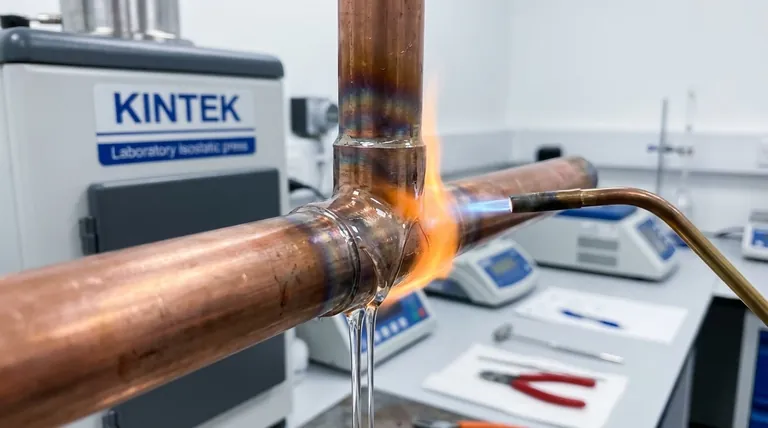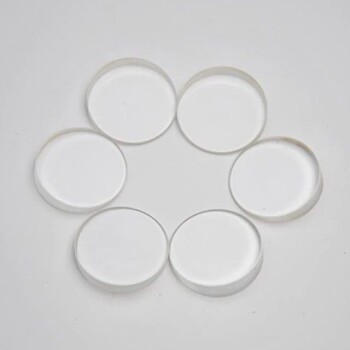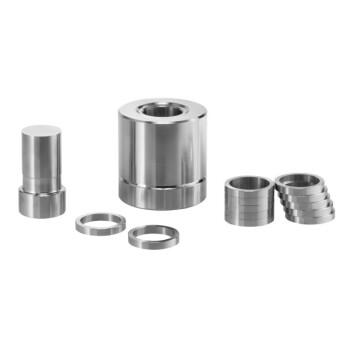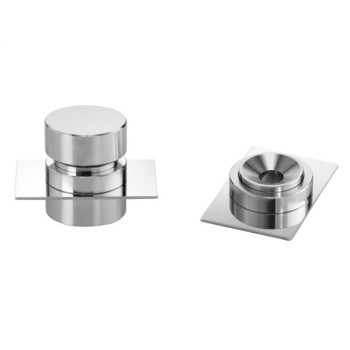Upon reaching brazing temperature, the flux transforms from a paste or solid into a chemically active, molten liquid. It flows across the joint surfaces well before the brazing filler metal melts. In this liquid state, its primary job is to dissolve existing metal oxides and form a protective barrier, creating a perfectly clean surface for the filler metal to bond to.
Flux is not a passive coating; it is an active chemical agent that melts before the filler metal. Its sole purpose is to chemically scrub and shield the base metals, creating a pristine, oxide-free surface that is essential for the braze alloy to wet the joint and flow via capillary action.

The Critical Functions of Flux
To understand what happens at temperature, we must first recognize the fundamental jobs the flux performs. It is more than just a surface coating; it is a multi-purpose chemical tool.
It Chemically Cleans the Surface
All metal surfaces, even if they appear clean, have a thin, invisible layer of metal oxide. This oxide layer prevents the molten braze alloy from making direct metallic contact with the base metal.
Flux contains active chemical compounds designed specifically to dissolve these stubborn oxides, effectively stripping the surface bare at a microscopic level.
It Provides a Protective Shield
Once the flux melts, it creates a liquid blanket over the entire joint area.
This barrier protects the hot, clean metal from oxygen in the surrounding atmosphere. Without this shield, the base metal would rapidly re-oxidize at high temperatures, nullifying the cleaning action.
It Enables Wetting and Capillary Action
Wetting is the ability of a liquid to spread across a solid surface. Molten braze alloy will only "wet" a surface that is perfectly clean and oxide-free.
By ensuring the surface is pristine, the flux allows the molten filler metal to spread out and bond. This wetting is what enables capillary action—the force that pulls the filler metal deep into the tight-fitting joint to create a strong, complete bond.
The Sequence of Events at Brazing Temperature
The entire brazing process relies on a precise sequence of events timed by temperature.
Step 1: Flux Activation
Flux is always engineered to melt and become chemically active at a temperature below the melting point of the braze filler metal.
This timing is critical. It ensures the cleaning and shielding work is completed before the filler metal becomes molten.
Step 2: Surface Preparation
As the flux becomes a liquid, it dissolves oxides and flows across the joint. The sight of flux turning clear and spreading is a key visual indicator that the part is approaching the correct brazing temperature.
Step 3: Filler Metal Flow
When the assembly reaches the filler metal's melting point, the alloy turns to liquid.
Because the flux has already created a clean, wettable pathway, the molten filler is immediately drawn into the joint, displacing the lighter-density liquid flux as it flows.
Step 4: Post-Braze Residue
After the joint cools, the flux solidifies into a hard, often glass-like residue. This residue has served its purpose and is now a contaminant.
Understanding the Trade-offs and Limitations
While essential for many brazing operations, flux is not without its challenges and requires proper management.
The Problem of Flux Residue
The chemicals that make flux effective at high temperatures often make it corrosive at room temperature, especially in the presence of moisture.
Leaving flux residue on a completed assembly can lead to corrosion that weakens the joint over time. Post-braze cleaning is a non-negotiable step for ensuring joint integrity and longevity.
Temperature Mismatches
Every flux has a specific active temperature range. If the temperature is too low, the flux won't clean effectively. If you overheat the joint or hold it at temperature for too long, the flux can become saturated with oxides and lose its effectiveness.
Alternatives to Flux
In certain industrial processes, flux can be eliminated entirely. Furnace brazing in a controlled, active atmosphere (such as hydrogen or dissociated ammonia) uses the atmosphere itself to reduce oxides on the part's surface.
This method is ideal for high-volume production and applications where flux residue is unacceptable, as it removes the need for post-braze cleaning.
Applying This to Your Project
Correctly managing your flux is the key to a successful brazing operation.
- If your primary focus is manual torch brazing: Use the flux as a temperature indicator. It should become clear and liquid just before you introduce the filler metal.
- If your primary focus is joint strength and reliability: Implement a mandatory and thorough post-braze cleaning process to remove all corrosive flux residue.
- If your primary focus is selecting materials: Always ensure the flux's active temperature range is compatible with the working temperature of your chosen braze filler metal.
- If your primary focus is high-volume, clean production: Investigate controlled atmosphere furnace brazing to eliminate the need for flux and the associated cleaning step.
Viewing flux as an active chemical tool, not just a passive coating, is the foundation for achieving consistently strong and reliable brazed joints.
Summary Table:
| Event at Temperature | Key Function |
|---|---|
| Flux Activation | Melts before filler metal to become chemically active. |
| Surface Preparation | Dissolves oxides and creates a clean, wettable surface. |
| Protective Shielding | Forms a liquid barrier to prevent re-oxidation. |
| Filler Metal Flow | Enables wetting and capillary action for joint filling. |
Achieve Flawless Brazing Results with KINTEK
Understanding the precise chemical behavior of flux is critical for joint integrity. Whether you are involved in manual torch brazing or high-volume furnace brazing, having the right equipment ensures precise temperature control and process consistency.
KINTEK specializes in high-performance lab furnaces and heating equipment, perfect for controlled atmosphere brazing that can eliminate flux and its residue entirely. Our solutions help laboratories and production facilities achieve cleaner, stronger, and more reliable bonds.
Let KINTEK empower your brazing process. Contact our experts today to discuss how our equipment can meet your specific laboratory and production needs.
Visual Guide

Related Products
- Warm Isostatic Press for Solid State Battery Research
- Laboratory Disc Rotary Mixer for Efficient Sample Mixing and Homogenization
- Laboratory Hydraulic Press Lab Pellet Press Machine for Glove Box
- Optical Window Glass Substrate Wafer CaF2 Substrate Window Lens
- High Purity Zinc Foil for Battery Lab Applications
People Also Ask
- What are some of the attractive properties of hot isostatic pressed products? Achieve Perfect Density and Superior Performance
- What is the temperature of a warm isostatic press? Achieve Optimal Densification for Your Materials
- How does Hot Isostatic Pressing reduce porosity? Eliminate Internal Voids for Superior Material Density
- What does hot isostatic pressing do? Eliminate Internal Flaws for Superior Part Performance
- What is the temperature of hot isostatic pressing? Achieve Full Density for Critical Components



















